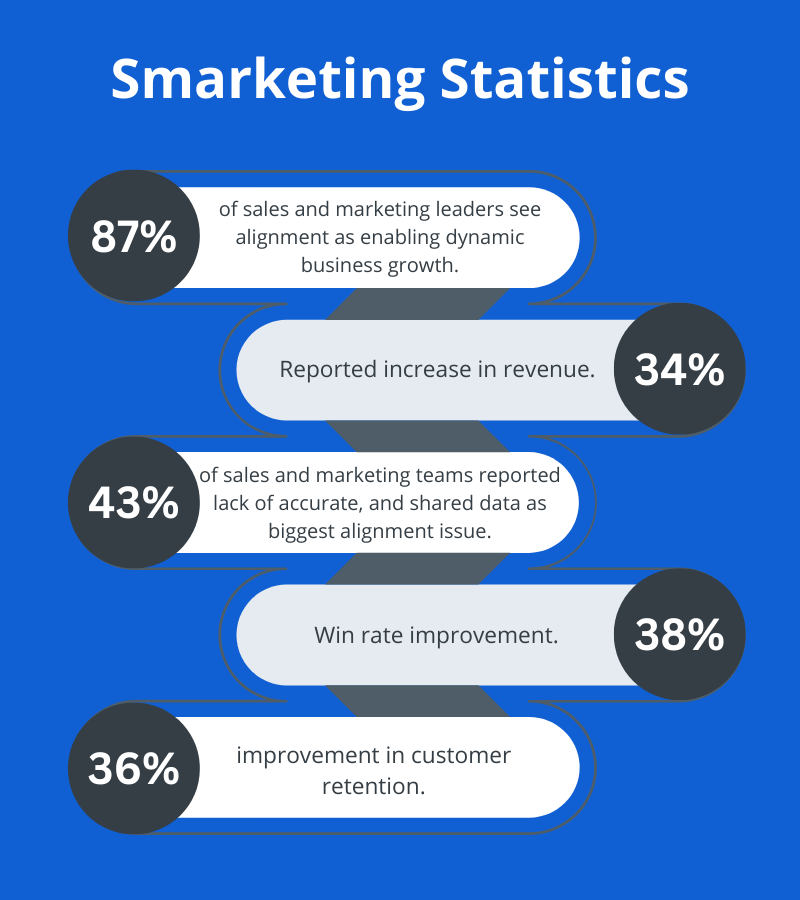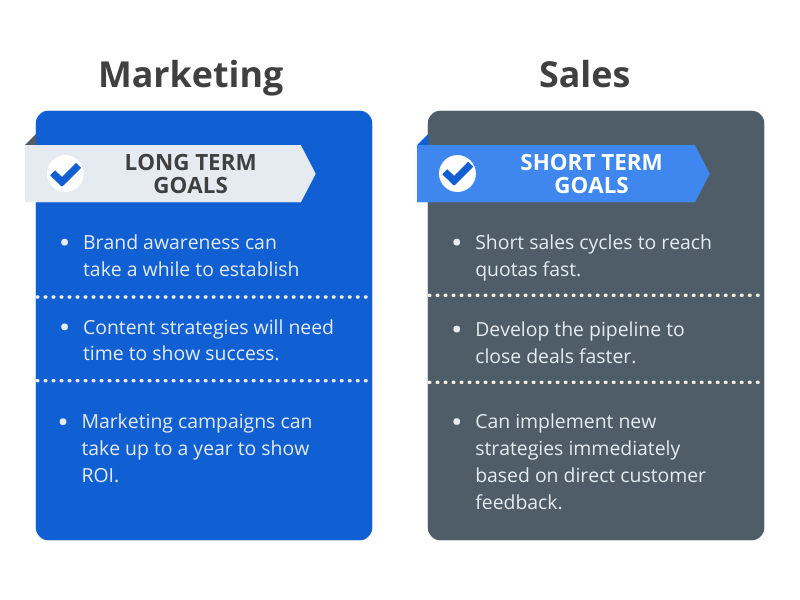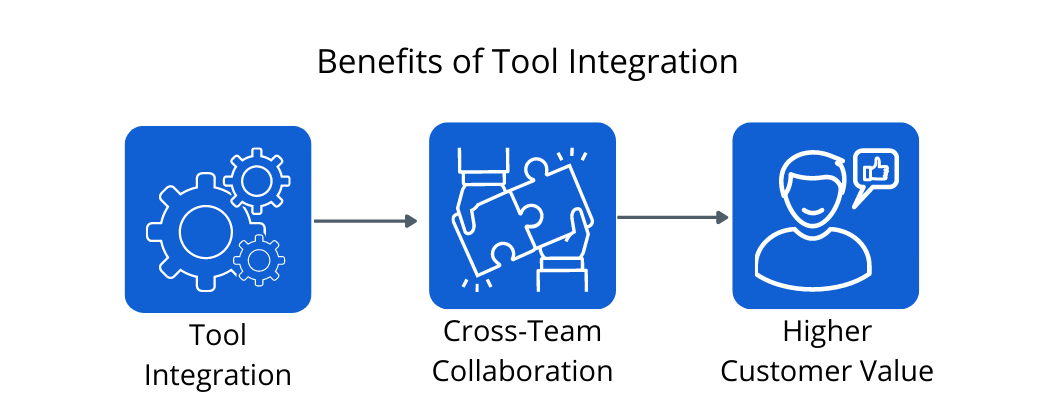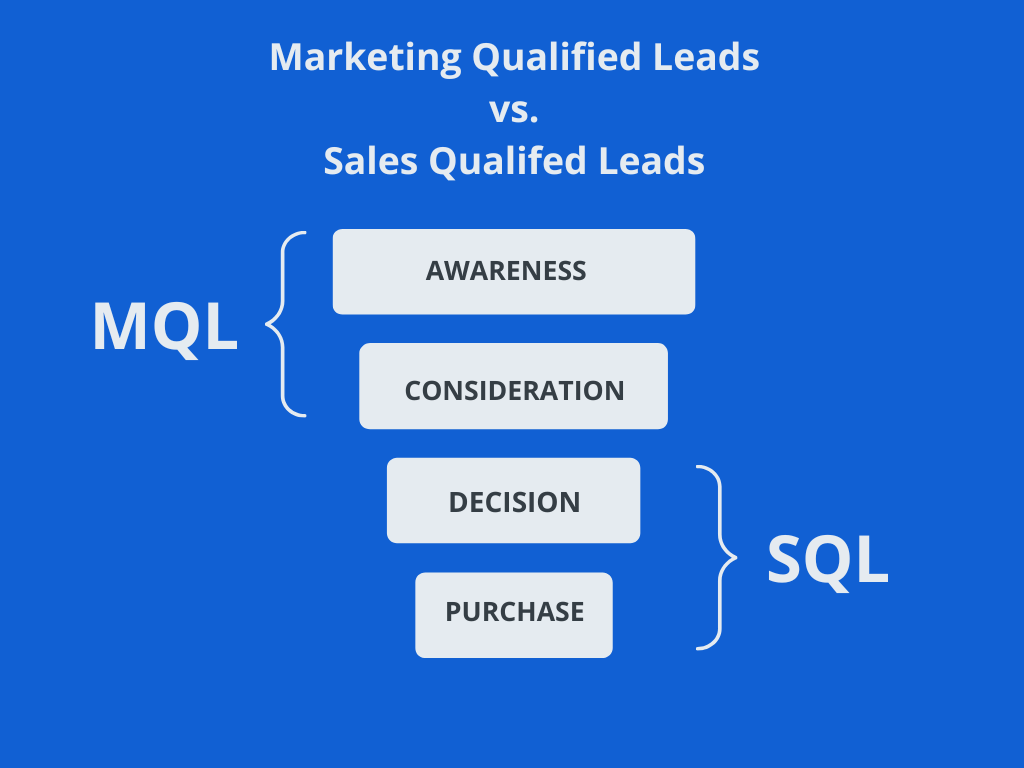If you’ve been in Sales or Marketing for a while, you’re probably more than aware of the marketing and sales alignment struggle. This struggle has come about because historically speaking, marketing and sales departments have always worked in silos.
In this article you will learn:
- What exactly is meant by marketing and sales alignment,
- How you can promote marketing and sales alignment in your company,
- How you can recognize that Marketing and Sales Alignment has worked.
What is Marketing and Sales Alignment in B2B Companies?
Marketing and sales alignment is the process of getting both teams on the same page and flowing in the same direction. Very often the work is happening but each team doesn’t know what the other is doing. In B2B, sales and marketing activities are crucial to the achievement of a company’s goals.
For this common goal to come to fruition, you need to align the people, processes, and make sure tools are working smoothly together. When all of that is in place, that’s when the magic of alignment starts to happen.
However, the impact of “Smarketing,” a term by which marketing and sales alignment is also known, is often underestimated.
What is Smarketing?
Smarketing is a portmanteau of the words sales and marketing and refers to the joint goals and processes of both teams as well as the push toward more transparency and communication. Having a smoothly running marketing and sales alignment process can mean a bump in your annual revenue which is ultimately what both teams want.
So what are the concrete benefits of Smarketing alignment? According to ServiceSource, alignment brought 36% higher customer retention rates and 38% higher win rates, leading to a 34% increase in revenue.

Statistics source: ServiceSource
A Decline in Marketing and Sales Alignment in 2022
Covid-19 and the dawn of new work has changed the business landscape dramatically. A report published by Copper back in February of this year stated that in 2022, 60% of sales and marketing professionals feel misaligned compared to 46% in 2021.
The switch to remote or hybrid working is what many consider the main reason behind this decline. Those working in larger companies (101-150 employees) and who are fully remote seemed to be hit the hardest citing feelings of disconnect with their teams.
We all know there are challenges and that tackling them successfully will have a huge impact, so where do we begin? Don’t worry, we’ve done the legwork for you and broken down some of the most important issues surrounding marketing and sales alignment.
What are the Most Common Issues Blocking Marketing and Sales Alignment in B2B?
Now that we’ve had a quick look at what marketing and sales alignment in B2B is, let’s take a look at the biggest obstacles to that alignment:
A Lack of Leaders to Instigate and Mediate Alignment
Many factors contribute to misalignment in marketing and sales. However, research shows that a lack of communication is the top reason, and we were curious as to why.
We reached out to Dipak Vadera, Director of Inbound Sales at Leadfeeder to get first-hand insights. He told us that communication issues initially exist because there is no role in the company that acts as the mediator between both worlds.

“Not having someone in this role is a common cause for misalignment. Each team tends to get caught up in its own priorities and doesn’t see how each is contributing to the bigger picture. This can lead to a loss of motivation in the long term because this creates a lot of frustration or friction between the teams. Marketing is sending over these leads they feel are qualified, but Sales isn’t following up on them. So having a communicator in between makes a big difference.”
Poor Communication and Visibility of Processes
As previously mentioned, the lack of communication and visibility is considered by many experts/teams as the leading cause of marketing and sales misalignment. When teams have a silo mentality that prevents them from exploiting the benefits they both have to offer, the big picture can never be clear.
This is why having that person between both worlds is vital to get the conversation started. However, the teams also have to participate for everything else to work. As someone who has worked in both Marketing and Sales, Dipak also gave us his thoughts on team communication and visibility:
“Marketing has always been able to see our dashboards but Sales never really got an inside view of what Marketing was doing. I mean, the concrete things to generate leads like campaigns and so on. Sales wasn’t aware of what Marketing was currently doing and what was upcoming.”
Dipak goes on to say that there’s very often very little visibility into how marketing content makes money. Marketing initiatives always need time to pay off and this is something that Sales doesn’t always understand.
Additionally, Sales doesn’t always have a great overview of the marketing assets available to them. It’s so time-consuming to find the piece of content that fits the needs of Sales at the moment they need it. In fact, according to Forrester, 60-70% of B2B content created is never even used because the topic is irrelevant to the audience.
Another huge pain point for Sales is not having insight into the buyer’s previous interactions with marketing materials. Not having an overview of the customer touch points in the funnel makes addressing customer pain points all the more challenging.
Using different tools for daily business can make it difficult for each team to gain insights into these interactions. CRMs and MAPs contain so much information and yet, these two tools aren’t made to truly communicate with each other.
These issues also underline the next obstacle to alignment—each team having a different set of priorities.
Priority Differences in B2B Marketing and Sales
Marketing’s main priority is to build a solid audience base and Sales wants to sell as much as possible to meet quota. On the surface, both these things don’t sound like they are complicated to communicate. But there are fundamental cultural differences between both teams which Dipak says should be addressed.
“Sales really doesn’t get enough insights into how Marketing works in a way they can understand and Marketing doesn’t have enough conversations with Sales to get insights into their goals.”
Brand awareness and sales conversions: it shouldn’t need to be said but ultimately, both of these priorities should lead to the same thing—more money. While Marketing employs a long-term, pull strategy where it takes longer to see the payoff, Sales uses a push strategy with short-term goals and almost immediate results.

Frustration on both sides stemming from different priorities can completely derail alignment, but it’s not only priorities that are different.
Differences in Metrics and Lead Qualification
Marketing and sales are also fundamentally different in terms of how they measure success. Sales use numbers: revenue, deals closed or retention, and Marketing gauges success in terms of impressions, engagements as well as brand awareness.
There is unfortunately also very often a huge disconnect between both teams in terms of what is considered a good or qualified lead.
According to a study by the TAS Group, 50% of the leads generated through marketing activities are not followed up on by Sales. And out of the 50% that do get through, 79% don’t even lead to sales. The most common reason for this is that each team has a different definition of what a qualified lead is.
5 Steps to Align Marketing and Sales in B2B
At this point, you’re probably thinking to yourself that all of this sounds rather grim. There are so many areas to work on that it can feel overwhelming because you’re not sure where to begin. Don’t worry! By assessing your company’s needs and identifying your pain points, you’ve already tackled the most difficult part.
We’ve put together 5 steps so you can get back to doing what your company does best, being a fantastic asset for your customer.

Step 1: Find an Alignment Champion
Sometimes starting a conversation is the hardest part of any relationship so sometimes, you may need a person whose role is exactly that: a mediator.
Having a marketing or sales manager doesn’t automatically mean that the two departments are constantly sharing information. As we talked about earlier, it’s often the case that there is no communication going on at all.
Dipak gave us his take on this:
“When I took on this role, there wasn’t actually anything negative going on but I approached this with the mindset of what potentially could happen if we didn’t lay the foundation. When companies scale, each team tends to forget that they have a common goal or lose track of the bigger picture. So (I thought), what if there was a middle person who sits between both teams and acts as the communicator?”
He says that finding someone who has worked in both Marketing and Sales is essential to the role. It adds neutrality to the alignment approach that would be otherwise challenging. Having someone who is only sales or marketing biased can throw a huge wrench into the work of alignment.
Step 2: Open up Lines of Communication and Create Visible Processes
Now that you’ve found your mediator, let them bring together both teams through transparency. The mediator acts as the bridge that allows communication to flow freely from one team to the other.
What should the teams talk about and make transparent? The short answer is: as much as possible. Opening up means each team has to take accountability for why things haven’t been working until now. Not a blame game, but just being realistic about what hasn’t worked until now, and figuring out a way to change that together. So what should the teams talk about?
Sales and Marketing Teams should have conversations about...
...goals, KPIs, and metrics
Each team should talk about goals early on. Be clear about what you want to achieve, how you plan to achieve it, and how you will measure success.
What does success look like for each team? Has each team presented its goals and Key Performance Indicators (KPIs) in a way that the other team can understand it?
Track the high-quality leads and their conversion rates. Was there specific content or a campaign that brought them to your sales funnel? What was the messaging that resonated with that target audience the most? Speak to your customers about what made them ultimately buy in.
Finally, the most important metric to track is revenue, and revenue growth. What isn’t working and what was it specifically that blocked growth? Talk about it!
...areas of responsibility
Identify who is responsible for each part of the customer journey and talk to each other frequently to share insights and relevant information. Use what you’ve found to break down the sales process and refine marketing content.
Why not put a Service Level Agreement (SLA) in place between both teams? Having a formal outline of the responsibilities and expectations allows for a clearer picture. Invite each other to see firsthand how these processes work in daily business. Reporting results is one thing, but seeing how everyone gets to these results is essential.
...current processes
Team members from each team should really deep dive into the processes of the other team. What do B2B sales reps do other than try and sell? What is the current marketing strategy for the next quarter? Dipak experienced that Marketing had access to the Sales dashboards but Sales never really got an inside view of what marketing was doing. Talk about upcoming marketing campaigns and how they can align with the needs of sales.
Sales teams should share insights gained from their customers and share them with marketing teams. Help Marketing better tailor content to the customer’s needs by telling them what the biggest pain points are. What are the issues that your customers bring up the most?
What is the greatest Marketing need? Understanding how they can provide better content for all parts of the funnel, and seeing that the content is used by Sales to lead to customer acquisition.
Step 3: Find Tools That Work With What You Have
We mentioned that Sales departments work with CRM tools and that Marketing departments work with MAP tools, but what can the teams use to close the gap? A Sales Enablement Platform (SEP) could prove to be your missing link.
Hubspot defines Sales Enablement as:
“...the iterative process of providing your business’s sales team with the resources they need to close more deals. These resources may include content, tools, knowledge, and information to effectively sell your product or service to customers.”

Having a single source of truth for both departments will cut the time-consuming search on the part of the Sales department to find appropriate content for their buyer’s journey. Marketing will also benefit by having greater insights into what happens behind the scenes in Sales from an SQL to an actual sale. Tools like Seismic or Showpad enables both Sales and Marketing an overview of each other's processes, allowing for greater transparency.
Start using marketing automation tools to cut down time spent on small tasks that your team could be investing in creating targeted content. Software such as HubSpot Marketing Hub or Active Campaign can help you save time when you're thin on resources.
Also, sales intelligence tools such as Echobot can help foster sales and marketing alignment. How? It can be used by both departments working towards the same goal: to boost business to a new level. Lead lists used by the sales team for cold calling could be used by Marketing to design LinkedIn campaigns.
Step 4: Create a Joint Definition of What a Lead is
Lead generation and qualifying are crucial to the success of any Sales or Marketing team but there is no mutual understanding of what a qualified lead looks like.
A Marketing Qualified Lead (MQL) is a lead who is interested in the brand because they are engaged with your company somehow. Perhaps they filled out a form on your website or downloaded a whitepaper because they have pain points that need to be addressed. However, at this stage in the funnel, you don’t know what those pain points are.
A Sales Qualified Lead (SQL) is one where the sales team has assessed the leads and decided it warrants a follow-up. So just because MQLs have landed on their laps, that doesn’t mean that these kinds of leads will turn into paying customers.

To start aligning the definitions, your teams should agree on an Ideal Customer Profile (ICP). This alignment creates more value for the customer because Marketing can start creating campaigns specifically targeting that audience which results in higher quality leads for Sales.
Don’t ignore lead nurturing! Just because someone isn’t ready at this point in the buying process doesn’t mean they won’t ever be ready. There is a tendency to want results quickly but sometimes not giving up on a lead can bring about a huge payoff down the line.
How do you Know When Marketing and Sales Alignment is Working?
So now you’ve identified the aspects that have caused the marketing and sales misalignment, and set up the alignment process using our 5-step process—now what? How do you know that things are going to plan?
You should start seeing a shortening of the sales cycle and an increase in sales effectiveness
According to Marketing Charts, the average B2B sales cycle with a new customer can last up to six months. With the alignment in place, your teams should see that timeframe reduced.
Don’t just focus on win rates or your quotas - these metrics alone will not tell you if your sales team is effective. Your sales rates have to also align with your company’s overall strategy to be considered effective.
Marketing should be able to deliver high-impact activities
Agreeing on lead quality and what the ICP is will allow Marketing to create highly-targeted content or campaigns that create real value for the customer. You will be creating a more engaged and loyal audience that is more willing to buy what you have to sell.
Revenue should increase
This should be self-explanatory but when everything comes together, you will see growth in your bottom line. But as your customers’ needs change or as you scale internally, you will need to revisit your alignment strategies to make sure they can change and scale too. You want a growth environment not just for the present, but also for the future.
Conclusion: Align Your Sales and Marketing ASAP
By now, you should have identified the value of what a marketing and sales alignment can do for your teams and business. Building a bridge between marketing and sales in the form of a mediator can vastly improve your alignment chances. But don’t just rely on a mediator, be sure to always take the initiative to keep communication flowing.
Like all processes, there is no “finished” product, but a work in progress. This means you will need to observe, analyze, and adjust your workflows to make sure you’re leveraging your findings. Be sure to document everything to make sure you can better monitor your progress. Having your steps documented keeps everyone in the loop through transparency and if things have gone well, you can use your findings to scale!
Ultimately, your customers will benefit the most from your marketing and sales alignment. Having aligned teams can give them a sense of stability and trust in your brand. And who knows? Your alignment success might just inspire them to try it out for themselves.
Download the Marketing and Sales Alignment Checklist!
Like what you’ve read here but want to have all the best practices on hand in .pdf format? Download the 5 Steps to Marketing & Sales Alignment checklist so you can see all the best tips for marketing and sales alignment at a glance.
We’ve also added a bonus tooltip section so you can be sure to have all your integrations ready to go when you are!
Thank you so much to Dipak Vadera for chatting with us!
If you’d like to know more about Dipak, please visit him on LinkedIn or visit his webpage where he talks about B2B sales, personal branding and being a full-time backpacker.
